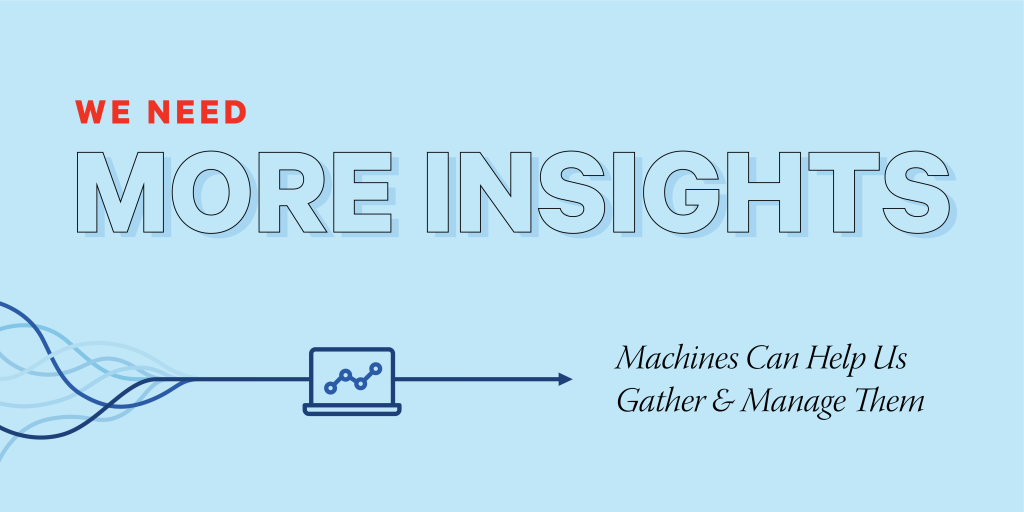We Need More Insights — Machines Can Help Us Gather and Manage Them

As Americans are bombarded with anywhere from 5,000 to 10,000 advertising messages a day, little insights like the behavior of women as they walk through a department store always have often the best marketers an edge that improves the likelihood that their message won’t get lost in the clutter—and that, having broken through the noise with a clear signal, they’ll convert a curious shopper into a converted purchaser.
The problem: None of us has the time to set up a lawn chair in the middle of various departments to watch consumers for hours and hours. Even our best insights too often arise from random observations. Those observations, while sometimes accurate and even helpful, are hardly rigorous—and that’s a problem, since your average Chief Marketing Officer is increasingly on the hook for answering where his budget went, why, and what results it yielded specifically.
That’s a tough spot to be in without data to back us up—and gathering that data can be a strenuous, tedious task when done manually.
Essentially, the problem is this: We need more insights and better ones. And we need to be able to convey the intelligence of our decision-making—as well as the ultimate value of our services—to the clients we serve.
The Cost of Spray-and-Pray Marketing
We’re paying a frightful price for marketing messages that don’t work.
Research by Dentsu Aegis Network finds that only a third of advertising messages get the full attention of their intended audiences. Essentially, we ask for a stack of 100 one-dollar bills from our clients, set 66 or 67 or them off to one side, and light them on fire.
Apparently, marketers’ performance has declined even more since pioneering retailer John Wanamaker complained 150 years ago, “Half the money I spend on advertising is wasted; the trouble is, I don’t know which half.”
Now we waste two-thirds. But that doesn’t have to be the case.
How Marketing Technology and Artificial Intelligence Can Help
Digital tools — creative uses of artificial intelligence and willingness to learn from rigorous data-based experimentation such as the work by Google’s Unskippable Labs and the Natural Language Processing (NLP) powered sentiment analysis tool developed at Onclusive — can help improve advertising and public relations performance. But they need to be used with discipline.
JiYoung Kim, the chief digital officer for Carat US, details in a recent Think With Google article some of the lessons her firm’s data scientists developed after crunching big piles of data from several campaigns.
Among the tips?
• If a video is promoting a deal, viewers tend to tune out once they hear the discount. Shorter formats will work well.
• Varying shots and frames keep attention levels high and drive action.
• If a jingle or some other sound is important, introduce it early in the ad when viewers are paying the most attention.
Of course, these all are insights that skilled marketers might develop on their own. Working hard over the course of a career, top marketers might come up with a half dozen brilliant insights by themselves.
Research driven by artificial intelligence and machine learning, meanwhile, produces dozens of actionable insights.
It’s difficult to set our ego aside long enough to let the technology do the work… but when we forgo smart tools paired with excellent strategy, we are likely leaving key insights about the needs, desires and behaviors of the people our work is meant to serve on the table. That’s unfortunate, especially if our speculative approach to marketing results in a creative flop.
Testing, Testing, Testing
The work by Carat US also reinforces the value of creative tests, helping us understand how elements of an ad impact sales and ROI.
We’ve been running tests forever in the marketing profession, but new tools allow our media teams to gather deep insights quickly as a campaign unfolds. This can be a critical advantage, particularly if we pair the power and speed of artificial intelligence with smart, clear business and storytelling goals as our Director of Insights and Strategy recently described in his lecture at G2 Reach.
Data-driven insights provide a powerful competitive advantage to the creatives who make magic happen for our clients, giving remarkably efficient tools to understand and make decisions based on what’s working and what isn’t. Armed with that knowledge, everyone responsible for developing and distributing content, as well as building audience relationships, can iteratively craft assets that improve our clients’ return on investment.
But this requires discipline. Our agencies need to invest consistently in research. This year’s insights are valuable; last year’s insights are so last year—except when you’re examining long-term progressions, which tools like data visualization platforms can help you to work with.
We need to be talking consistently, too, with our clients about the value of investments in testing. They’re spending substantial amounts of dollars on messaging, and they have a great interest in making sure it’s done right. A forthright conversation between an agency that’s eager to learn and a client who’s eager to succeed can pay big benefits. Ethnographic interviews—a qualitative form of research that first found its footing in the study of oral history via anthropology—is just one highly effective way to do that.
Up Level Your Potential with Powerful Tools
The best marketing agencies always will be those that manage to combine data-driven knowledge with the insights developed by staff members who are close observers of human behavior. It’s important to remember that, while deeply sophisticated, the data collected by machines can only be useful if the teams interpreting it have a strong understanding of their goals, key performance indicators, relationship-building, and their communities in their playbook.
Which brings us back to those women walking through the apparel section of the department store:
As Carat was working recently with a client to sharpen its creative for consumer products, they discovered that videos improved purchase considerations by women by 6.9 percent when they highlighted “softness.” This was a very basic insight gleaned from experimentation with creative that demonstrated a clear relationship between content produced and purchases made. With that information, Carat and its client was positioned to develop the right creative to drive sales among an important audience group.
The more you know, the better you do. That’s an insight to take with you to work.



